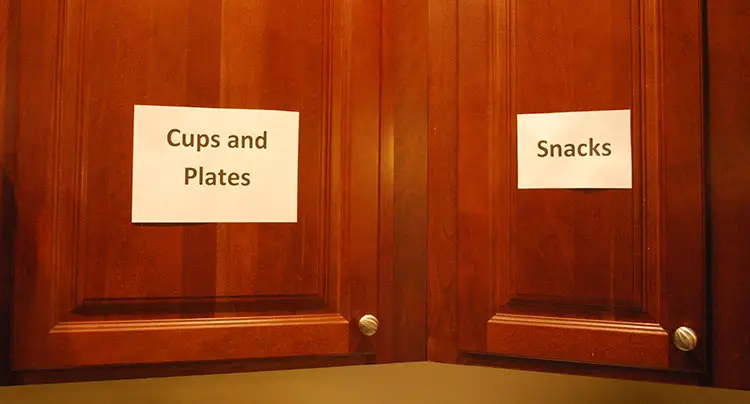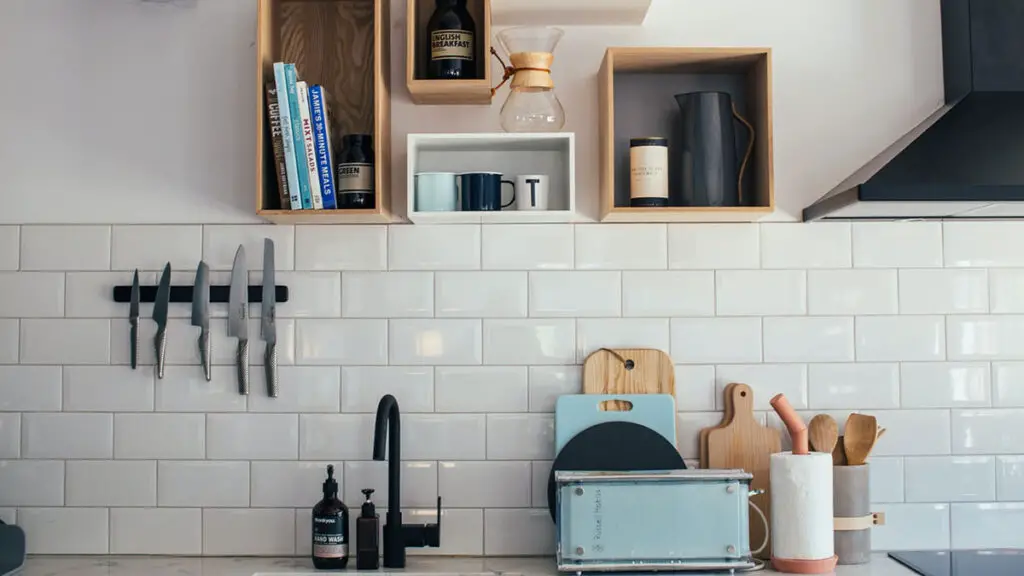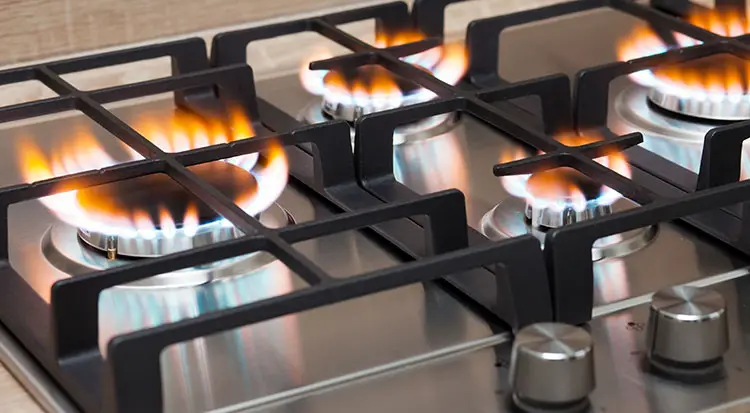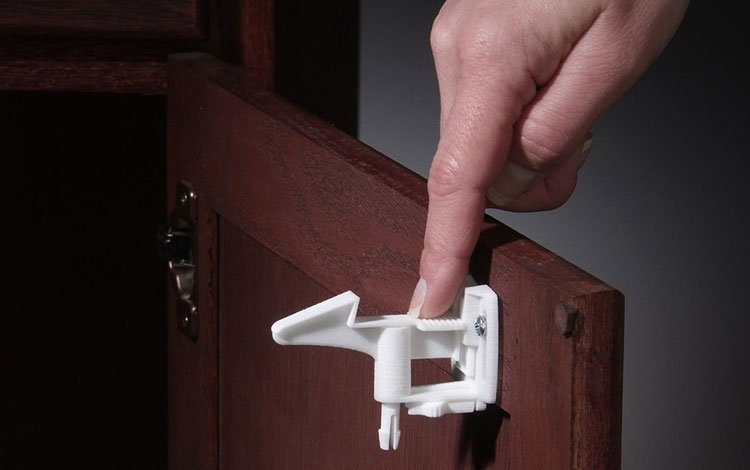Along with the bathroom, the kitchen is one of the most dangerous rooms in the house for someone with dementia. Sharp knives, breakable dishes, small and large appliances, and hot surfaces present dangers.
Alzheimer’s Disease Kitchen Safety Checklist (PDF)
In most homes, the kitchen is also a popular gathering place, a warm and inviting room where families and guests spend a lot of quality time together, connecting through food and conversation. It is imperative to pay special attention to making the kitchen as safe as possible to include your loved one’s use of the space.
Step One: Survey the Look and Functionality of the Kitchen
As with the other rooms, survey the kitchen’s general look and feel. Look at the big picture as you assess the room. Peruse the space to make sure pathways are clear for someone wandering in and out. Kitchens are often a high-traffic room for families so it’s important for this space to be functional, yet safe.
- Make sure chairs are easy to get in and out of and within earshot of kitchen happenings. If the kitchen is generally where a lot of family time is spent, try to include a chair for your loved one to sit near the action, where he or she will feel a part of things. Also, make sure there is enough padding. If the chair is too hard on their bottom, this could cause this area to fall asleep, which would make walking even more challenging.
- Good lighting in the kitchen, as in other rooms, is necessary to aid in daily activities. We all need to see what we are eating at mealtimes, but this is ever more important for the person with dementia. Vision and perception in the older person may be continually changing, which can be further impacted by dim lighting. Make sure lighting is adequate overhead and that night lighting includes a nightlight or two, depending on the size of the kitchen.
- Look at kitchen flooring with a critical eye. Kitchen floors get wet, particularly in front of the sink, so consider this when assessing safety. If your floors are tile, you may have to apply or hire someone to apply a non-skid adhesive on top. For linoleum or hardwood, assess for safety by wetting the floor. Apply some type of covering if it is slippery when wet.
- Make sure kitchen furniture is comfortable and sturdy. Dining chairs should have arms to assist getting in and out of them. The dining table should be sturdy to the touch. Pedestal tables are dangerous if someone tries to climb on top of them. Consider removing them.
- Cover the table with a tablecloth that contrasts with the floor if it is shiny. The shine can be irritating and bothersome.
- Other furniture besides the dining table can pose a threat. You might consider removing furnishings such as baker’s racks and footstools, both of which can be used for climbing. Plain bar stools might be in the way while also being a seating hazard. Without arms, it is much easier for the older person to slip off onto the floor.
Step Two: Make Sure Appliances Do Not Threaten Safety
- The stove is one of the biggest dangers in the kitchen. Remove the knobs when the stove is not in use or install a switch to turn off the power. Cover the burners when not in use to detract attention.
- The oven is a major concern. Putting a lock on it may be the best way to ensure the individual’s safety and the caregiver’s peace of mind. Appliance locks are easily attached and automatically lock when set to the “on” position. Lock it when off, too. You might be surprised how many older people stop using their ovens for cooking but use them for storing kitchen items, such as pots and pans. This might work just fine until the oven goes on and melts pot handles and whatever else might be inside.
- Limit access to the microwave. The person with dementia does not realize that putting metal or aluminum in a microwave can start a fire. He or she may put items in and turn on the timer for hours, resulting in burned food or objects and a potential fire hazard.
- The refrigerator may pose a danger. Place items your loved one might need on a shelf that is easy to reach and at eye level. If the dementia has progressed to the point where free access to the refrigerator is dangerous, it may be necessary to lock it up along with the stove. The person with dementia might eat raw food, old food, or drop breakable jars.
- Small appliances can pose a danger, too. Unplug them and insert safety plugs into the outlets. If you have room in the cabinets, consider removing appliances (when reasonable) from the counters and placing them there. Look into small appliances that shut off automatically. You can get coffeemakers and tea kettles, for instance, which shut off automatically. Keep small appliances away from the sink to avoid any contact with water.
Step Three: Address the Sink and Garbage Disposal
- This garbage disposal is a definite danger if kept connected. Disconnecting it will ensure that items aren’t stuffed down the sink or, worse, that human hands get mangled. If you don’t want to stop using the disposal, spend the money to buy one with a safety feature. There are garbage disposals on the market that will not run unless a cover is in place. This invention works differently than the traditional disposal which requires water running down the drain while grinding. With the way this one works, fingers, silverware, or other small items cannot get chopped up. This is a wonderful appliance for households with children or cognitively impaired individuals. Another plus—this apparatus is also quiet.
- Automatic faucets and anti-scalding devices also work well in the kitchen. If you do not have an automatic shut-off device on your faucet, hide the sink stoppers to prevent the sinks from getting clogged and overflowing.
- Add drain screens to prevent losing anything down the drain.
Step Four: Focus on Cabinets and Cupboards
Several potential dangers are lurking in your kitchen cabinets. There are dishes that can be broken, heavy pots that can fall on a toe, and food, including spices, that shouldn’t be eaten without being cooked. Dangers linger with sharp knives, cleaning supplies, and plastic bags. Yes, plastic bags. A seemingly innocuous plastic trash bag can become a choking or suffocation hazard in seconds.
- The easiest way to prohibit access to these types of items is to install child-proof safety latches on all the cabinets. These are inexpensive and easy to install.
- UPGRADED VERSION - taking to heart feedback from our customers, this new version features a longer hook arm that works even in kitchens with countertop overhangs. It also has greater adhesive surface area for greater security!
- EASY FOR ADULTS TO OPEN, SECURE AGAINST KIDS - The locks can handle at least 20lbs of pull tension, more than enough to keep cabinets locked against kids. Meanwhile, parents and adults can easily open locked cabinets with one press against the spring-loaded latch, without any need for special keys or magnets.
- Cabinets may also be camouflaged by painting the cabinet pulls a color similar to that of the cabinets. Be mindful that denying access to kitchen cabinets could cause frustration to the person with Alzheimer’s making his or her way to the kitchen for a snack. If your loved one can go to the kitchen and make a snack, creating a safe environment to allow this will afford your loved one greater independence. Consider loading a few shelves or drawers with certain foods. Stock designated locations with snack items such as crackers, cookies, granola bars, fruit, or any other favorites.
- Label cabinets with words such as “snacks” or a picture of foods if the ability to read has declined. Lettering should be large and bold with a block font as opposed to script.

Step Five: Watch Eating and Dining
There are hazards in the kitchen that you may not realize. A person with Alzheimer’s will often get to the point where they will eat a number of non-edible items.
- Do you have a bowl of artificial fruit? Remove it. In fact, you might remove a bowl of real fruit if eating too much of it becomes a problem.
- Refrigerator magnets can also pose a danger. Small magnets that look like food might be mistaken for just that and swallowed.
- Check your counters and windowsills for other small items that could be swallowed. Remove them from the kitchen.
- Look at colors. Distinguishing food from the plate that holds it may become more difficult. Colored plates may help highlight the food for your loved one.
- There are several adaptive items you can purchase to make your loved one’s dining experience easier and more pleasant. As people get older, their diminished motor skills make forks and drinking glasses harder to hold and manipulate. With dementia, cognitive issues affect perception and understanding, as well. The person may be confused about how to use the objects in front of him or her, or embarrassed that he/she cannot hold his/her spoon steady.
- Keep all alcohol in a locked cabinet. Drinking alcohol can increase confusion.
You’ve looked at the lighting and the dining area itself. Now, look further into the details that go into creating an ideal eating experience.
As with any other room, color contrast is helpful. You’ve made sure the table does not blend in with the floor, perhaps with the aid of a tablecloth. If you use placemats, make sure that the color contrasts with the tablecloth and with the plates. People with dementia have a hard time perceiving boundaries when colors blend together. Being able to find their food will make eating easier. Here are a few more tips:
- Purchase non-skid placemats and non-skid dishes. This is just an extra safety measure to prevent accidents. Specialty plates include those with high rims or bumper guards to keep food from being pushed over the edges onto the table.
- A glass or mug is never a good idea unless it is heavy-duty and non-breakable. It may be hard to figure out just the right size of cup that is easy for the older, arthritic hand to hold. Consider investing in specialty cups that are ergonomically shaped for easier gripping. Some come with built-in straws that make drinking easier.
- Adaptive utensils also come in many different forms. Weighted forks and spoons are common in nursing homes, as they help steady the fork. All these items not only ensure safer dining, but they also afford the people with dementia as much independence as they can handle for as long as they are able.
- Large Easy-Grip Handles - Our adaptive utensils feature large easy-grip handles with lightweight foam for maximum hold
- Supportive Utensils - Our specially designed assistive utensils make eating easier for elderly or those with weak hand grip, arthritis, and more
- Remove heavy pots and pans if you’re loved one is still cooking or helping you in the kitchen. Heavy-duty ceramic pots, for instance, are extremely heavy. If your loved one tries to picks these up, they could become injured.
After all of this, if you’re still worried about your loved one getting into trouble in the kitchen, you can install a motion detector that will alarm when he or she goes into the room.
If you do buy an in-home camera surveillance system, definitely include the kitchen in your monitoring. The noise from a motion detector can be an annoyance, so the best monitor for causing the least amount of distress may be a simple, low-cost baby monitor. Just have a monitor with you where you can hear if something inappropriate is going on in the kitchen.
Finally, have a fire extinguisher handy. Something unexpected can happen despite your best efforts. Make sure a smoke and fire detector are installed with fresh batteries that are frequently checked.
- First Alert's HOME1 FE1A10GR Fire Extinguisher is UL rated 1-A: 10-B:C; it features durable all-metal construction with a commercial-grade metal valve and trigger to meet demanding needs
- Multipurpose fire extinguisher fights wood, paper, trash, plastics, gasoline, oil, and electrical-equipment fires
Alzheimer’s Disease Kitchen Safety Summarized
Having the ability to take care of oneself will maintain the highest level of functioning in your loved one for a while longer. Allowing access to familiar items will afford the person some freedom and sense of being in control of his or her own life, which will make them happier.
As your loved one’s illness progresses, however, there may come a time when the kitchen is just too dangerous and must be added to the list of rooms that are off-limits, at least without supervision.
This is the fifth article in this series. Further articles will cover other rooms:
- General Home Safety
- Bathroom Safety
- Living Room Safety
- Bedroom Safety
- Hallways and Entryways
- Outside the Home
Check each of these articles as they become published to continue your home safety assessment.
Want to read my complete guide? See Staying Home.
- Grant, Derrick (Author)
- English (Publication Language)








